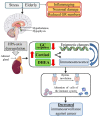Role of Endogenous Glucocorticoids in Cancer in the Elderly
- PMID: 30486460
- PMCID: PMC6321146
- DOI: 10.3390/ijms19123774
Role of Endogenous Glucocorticoids in Cancer in the Elderly
Abstract
Although not a disease itself, aging represents a risk factor for many aging-related illnesses, including cancer. Numerous causes underlie the increased incidence of malignancies in the elderly, for example, genomic instability and epigenetic alterations that occur at cellular level, which also involve the immune cells. The progressive decline of the immune system functions that occurs in aging defines immunosenescence, and includes both innate and adaptive immunity; the latter undergoes major alterations. Aging and chronic stress share the abnormal hypothalamic⁻pituitary⁻adrenal axis activation, where altered peripheral glucocorticoids (GC) levels and chronic stress have been associated with accelerated cellular aging, premature immunosenescence, and aging-related diseases. Consequently, changes in GC levels and sensitivity contribute to the signs of immunosenescence, namely fewer naïve T cells, poor immune response to new antigens, decreased cell-mediated immunity, and thymic involution. GC signaling alterations also involve epigenetic alterations in DNA methylation, with transcription modifications that may contribute to immunosenescence. Immune cell aging leads to decreased levels of immunosurveillance, thereby providing tumor cells one more route for immune system escape. Here, the contribution of GC secretion and signaling dysregulation to the increased incidence of tumorigenesis in the elderly is reviewed.
Keywords: cancer; elderly; genomic instability; glucocorticoids; immunosenescence.
Conflict of interest statement
The authors declare no conflict of interest.
Figures

Similar articles
-
Stress, glucocorticoids and ageing of the immune system.Stress. 2005 Mar;8(1):69-83. doi: 10.1080/10253890500100240. Stress. 2005. PMID: 16019599 Review.
-
The role of immunity in elderly cancer.Crit Rev Oncol Hematol. 2010 Apr;74(1):40-60. doi: 10.1016/j.critrevonc.2009.06.002. Epub 2009 Jul 4. Crit Rev Oncol Hematol. 2010. PMID: 19577481 Review.
-
Potential role of immunosenescence in cancer development.Ann N Y Acad Sci. 2010 Jun;1197:158-65. doi: 10.1111/j.1749-6632.2009.05370.x. Ann N Y Acad Sci. 2010. PMID: 20536845 Review.
-
The role of stress factors during aging of the immune system.Ann N Y Acad Sci. 2009 Feb;1153:139-52. doi: 10.1111/j.1749-6632.2008.03966.x. Ann N Y Acad Sci. 2009. PMID: 19236337 Review.
-
Neuroendocrine and viral correlates of premature immunosenescence.Ann N Y Acad Sci. 2015 Sep;1351:11-21. doi: 10.1111/nyas.12786. Epub 2015 May 5. Ann N Y Acad Sci. 2015. PMID: 25943573 Review.
Cited by
-
Glucocorticoid and PD-1 Cross-Talk: Does the Immune System Become Confused?Cells. 2021 Sep 6;10(9):2333. doi: 10.3390/cells10092333. Cells. 2021. PMID: 34571982 Free PMC article. Review.
-
Chronic Stress Related to Cancer Incidence, including the Role of Metabolic Syndrome Components.Cancers (Basel). 2024 May 28;16(11):2044. doi: 10.3390/cancers16112044. Cancers (Basel). 2024. PMID: 38893162 Free PMC article.
-
Horse Meat Hydrolysate Ameliorates Dexamethasone-Induced Muscle Atrophy in C57BL/6 Mice via the AKT/FoxO3a/mTOR Pathway.Cells. 2025 Jul 9;14(14):1050. doi: 10.3390/cells14141050. Cells. 2025. PMID: 40710303 Free PMC article.
-
Sialic Acid-Siglec Axis as Molecular Checkpoints Targeting of Immune System: Smart Players in Pathology and Conventional Therapy.Int J Mol Sci. 2020 Jun 19;21(12):4361. doi: 10.3390/ijms21124361. Int J Mol Sci. 2020. PMID: 32575400 Free PMC article. Review.
-
Clinical and Histopathological Characteristics of Colorectal Cancer in Iraq between 2015-2021.Arch Razi Inst. 2022 Dec 31;77(6):2407-2413. doi: 10.22092/ARI.2022.358613.2263. eCollection 2022 Dec. Arch Razi Inst. 2022. PMID: 37274881 Free PMC article.
References
Publication types
MeSH terms
Substances
LinkOut - more resources
Full Text Sources
Medical
Miscellaneous

